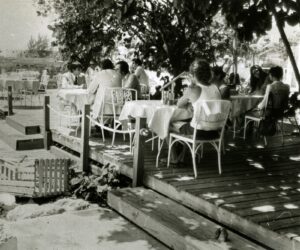I didn’t flush up the yellow-crowned evening heron. The Key deer did.
However me slowing down on Watson Boulevard to get a greater take a look at the Key deer may need impressed the half-pint ungulate to begin moseying down the shoulder of the highway, thus flushing the evening heron.
The hen didn’t climb very excessive, simply three or 4 ft above the bottom. It flew in an unhurried straight line, parallel to my automotive, for 30 or 40 yards. Then it banked arduous and disappeared right into a thicket of leafless branches.
I drove on for some time, then acquired vaguely curious, turned the automotive round, and parked on the alternative aspect of the highway from its level of disappearance.
At first I wasn’t certain I’d stopped on the proper thicket. All I might see was an summary assortment of near-colorless twigs and branches. However then I discovered the hen proper in the midst of all of it, two ft tall and weighing a couple of pound and a half, leaning ahead a number of levels, staring down in direction of the bottom with its pumpkin orange eyes.
Grownup yellow-crowned evening herons have one thing I’d classify as a sartorially put-together look, borderline dapper and dashing. They’re grey within the physique, as if carrying some form of well-cut go well with, with some white fringing within the flight feathers. They’ve a black, rectangular head, pleasing as a fedora, underscored by a particular white cheek, a pair of feathers trailing to their nape, and a stable, no-nonsense, longish invoice. Generally you catch sight of the nominate yellow crown.
Immature yellow-crowned evening herons, once I see them, usually recall to mind a phrase my buddy Robert taught me – frowzy – which at first I believed he made up, however seems to be legit English. It means scruffy or neglectful in look, or typically not put collectively.
The hen I used to be was a mishmash of browns and blacks and grays. It takes a yellow-crown three or 4 years to achieve grownup plumage. After their first summer time, they have a tendency to get a considerably streaky sample within the breast and face, and this hen had none of that happening, which means it was almost certainly simply beginning its first summer time of life.
Any hen with evening within the title sounds form of cool. It brings an air of secrecy. I believe it’s why Edward Hopper selected “Nighthawks” for the title of his most well-known portray. However the title has at all times bothered me a bit in its ornithological aptness.
Nighthawks, for one, aren’t truly hawks. They’re within the nightjar and goatsucker household. (Goatsucker is derived from the idea that they stole milk from goats whereas everybody was sleeping. Which isn’t true.) In an anthropomorphic sense nighthawks don’t have a variety of edge. They don’t seem to be cool, composed birds that spend their evenings staring off into house. Habits-wise, they arrive off extra on the frenetic finish of the spectrum, bordering on spastic, flying by means of the darkish skies of the late hours in a continually altering and discursive sample. After all the sample is just not random a lot as improvised, guided by their means to vary course straight away and nab the airborne bugs that make up the huge bulk of their weight-reduction plan. However all of this doesn’t essentially jibe with a portray of a small group of individuals in a principally empty diner, in postures that convey a way of inarticulable magnificence underscored by a rumbling of loneliness and existential dread.
Night time herons, by comparability, are precise herons, constructed for a lifetime of grabbing up aquatic issues at their ft. Although the yellow-crown’s weight-reduction plan is extra restricted than most members of the ardeidae household, with about 80% of it made up of crabs, in the event that they reside close to salt water, or crayfish in the event that they reside additional inland. Of the eight species of herons present in North America, they’re thought-about essentially the most sedentary forager.
They was categorised in the identical household because the black-crowned evening heron, however had been lately moved to a household during which they’re the one extant member.
In 1978, the South Florida ornithologist James Kushlan described 38 feeding ways employed by herons. The yellow-crowned evening heron has been noticed to make use of 5 of them: standing, head swaying, neck swaying, pecking, and strolling slowly. About 75% of their foraging time falls into the class of standing, interspersed with quick intervals of gradual strolling, which takes up about 20% of their foraging time.
My level right here being that if any kind of nocturnal hen feels behaviorally simpatico with the scene of what Tom Waits described as chilly caffeine in a nicotine cloud portrayed in “Nighthawks” – what with their flannel grey feathers and their staring-into-space demeanor – it’s evening herons, not nighthawks.
The issue, in fact, is that “Nighthawks” is a poetic title. And poetic reality doesn’t at all times match actual world information. (There are fairly just a few individuals who will argue that poetic reality runs deeper than the information.) And the mechanics of poetry are largely about rhythm and circulation, and sadly “Night time Herons” falls quick, not scanning very properly, missing the identical cool ring.
Additionally, Hopper completed the portray in 1942 and died in 1967, and the portray is without doubt one of the most well-loved photos within the American visible canon. It appears unlikely to be changeable now, regardless of the dearth of ornithological correctness.
The yellow-crowned evening heron I used to be watching on Massive Pine spent a very long time searching in standing mode. So lengthy that I considered transferring on earlier than he did. However then he dropped all of a sudden down into the muddy puddle on the base of the thicket, snatching up some crustacean-derived energy he wanted to proceed on the trail to maturity.


